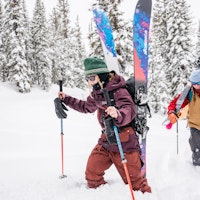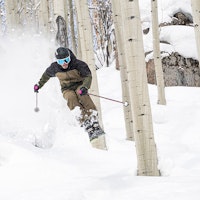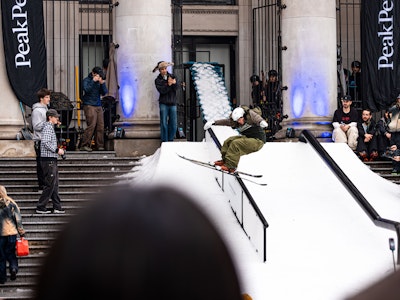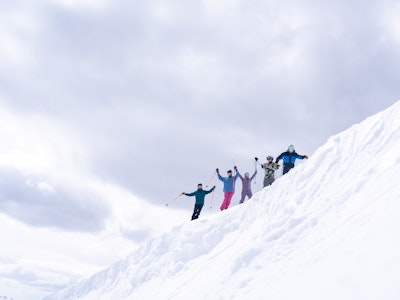As seen in the February 2012 issue of FREESKIER.
Words: Ryan Dunfee — Photo: Chris O’Connell
Skiing is having another identity crisis. We’re headed back to the Olympics after shucking their narrow idea of what skiing could be, and we’re still just a little bit insecure with our standing as an “action sport,” up there with the relatively unified counterculture perception of snowboarding, skateboarding, and surfing. While skiing’s history of convention and establishment have kept us from being as successful in exuding a rebellious image—something we’ve lamented off and on since freeskiing’s informal birth in 1997—it may be time to recognize that skiing stands on its own two feet for a different set of reasons. There, doesn’t that feel better already?
In the 35,000-foot cultural view, skiing has generally represented the establishment and the conventional way of doing things. Thankfully, for those of us who actually ski, we’ve been blessed with a host of heroes in the past 40 years who have redefined the parameters of the ski experience. Skiers like Wayne Wong introduced hot-dogging in the early 1970s, which for the first time in skiing’s history emphasized style over speed. In the late ‘80s, a formerly jailed car thief, Glen Plake, who was introduced as a “Mohican terrorist” in Greg Stump’s timeless Blizzard of Aahhhs, went to Chamonix with Mike Hattrup and Scot Schmidt. They then billy-goated down every crevassed-out couloir they could find and introduced extreme skiing to the world. Ten years later, at the awards ceremony of the first U.S. Freeskiing Open at Vail, JP Auclair held up the first pair of yellow Salomon 1080s and freeskiing had its first vessel for creativity. A few weeks later, Jonny Moseley won the Nagano Olympic mogul competition with an immaculate 360 mute grab, left pole poked high into the air, and redefined for a worldwide audience what skiing could be. And that was when the story was supposed to be about snowboarding’s first Olympic halfpipe contest only a few venues over.
Even outside of these revolutionary events, skiing has at times owned the counterculture narrative as much as skateboarding or surfing. In the ‘70s, we were on par with rock stars—the only ones to ever match Mick Jagger in their indulgence in grime, sex, drugs, and alcohol. But not since. While the ski bum, lying unshaven with a few tabs of acid still left in his pocket in a propane-heated van or some forgotten attic of a now-ritzy ski town, will always be our strongest claim to filthy authenticity, our roots aren’t truly planted in that ideal.
But instead of ruing our lack of a unified counterculture and looking at the other action sports with envy, we can look at our own diversity as a strength. I’m not talking about the kind of diversity anyone else in the world would understand; that kind of inclusion hasn’t come close to taking over skiing. But we now see skiers with professional careers dedicated to alpine racing, moguls, aerials, slopestyle, halfpipe, big mountain, skiercross, ski jumping, randonee racing, ski mountaineering, tele-skiing, ski-BASE jumping, speedflying and even Chinese downhill, now in sanctioned form as Daron Rahlves’ Banzai Tour. This is supplemented by the plethora of film-and photo-based careers that fill in every possible gap along the way and crews like Line’s Traveling Circus and Nimbus Independent that continue to redefine what a legitimate day of skiing looks like.
The diversity of the ski experience is pretty astounding—greater than what any other action sport has offered thus far. Undoubtedly, the cool factor of freeskiing has been diluted in the public eye by its proximity to ski racing and its strict norms, as well as the tamer and the more luxurious faces of skiing most people are familiar with. But what we lose in public perception, we gain in a broader cross-fertilized experience. Each discipline of skiing bolsters the other. Racers who turn into big-mountain skiers have the technique to attack vertical lines with incredible speed. The randoneers and backcountry purists have helped many types of skiers get outside resort ropes and crawl around the backcountry with an increasing diversity of products. And the mogul skiers and aerialists helped develop the air awareness of freeskiing’s first generation.
The variety of the skiing experience may be its strongest asset and our saving grace. With so many personalities clicking into skis to do so many different things, it’s vastly more difficult for an outsider to grab an image of a skier, slap an ad on it to try to sell deodorant, and hope the plebe on the other end feels some enduring sense of counterculture identity. Given that, it shouldn’t come as any surprise that there are so many more (or any) snowboarding video games than ski ones. That variety may indeed help skiing remain more about the skiing than any sort of more overarching ideal. But it remains to be seen how this next generation, the first to be raised entirely on twin tips and without the memory of freeskiing’s first struggles, defines this great and simple sport of ours. Will they enter another cycle of whittling skiing back down to their own set of competitive and stylistic rules, or will we see the sport open up as the cross-pollination of ideas and styles continues across skiing’s many genres?
FREESKIER welcomes submissions of stories, opinion and art for Talk. E-mail to Talk@freeskier.com.
Take Freeskier.com with you everywhere you go. Download the refined version 2.0 of our iPhone and iPad app for easy access to the latest news, photos, videos, snow reports, gear reviews, games and more.
![[GIVEAWAY] Win a Legendary Ski Trip with Icelantic's Road to the Rocks](https://www.datocms-assets.com/163516/1765233064-r2r26_freeskier_leaderboard1.jpg?w=200&h=200&fit=crop)
![[GIVEAWAY] Win a Head-to-Toe Ski Setup from IFSA](https://www.datocms-assets.com/163516/1765920344-ifsa.jpg?w=200&h=200&fit=crop)


![[GIVEAWAY] Win a Legendary Ski Trip with Icelantic's Road to the Rocks](https://www.datocms-assets.com/163516/1765233064-r2r26_freeskier_leaderboard1.jpg?auto=format&w=400&h=300&fit=crop&crop=faces,entropy)


![[GIVEAWAY] Win a Head-to-Toe Ski Setup from IFSA](https://www.datocms-assets.com/163516/1765920344-ifsa.jpg?auto=format&w=400&h=300&fit=crop&crop=faces,entropy)



